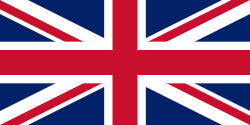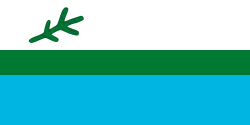Flag of Newfoundland and Labrador

The flag of Newfoundland and Labrador was introduced in 1980, and was designed by Newfoundland artist Christopher Pratt. The flag design, with the proportions 2:1, was approved by the House of Assembly of the province of Newfoundland and Labrador, Canada, on May 28, 1980. It was flown for the first time on Discovery Day; June 24, 1980.
The design was chosen due to its broad symbolism. The blue colour represents the sea, the white colour represents snow and ice, the red colour represent the effort and struggle of Newfoundlanders and Labradorians, and the gold colour symbolizes the confidence Newfoundlanders and Labradorians have in themselves and for the future.
The blue triangles are meant as a tribute to the Union Flag, and stand for the British heritage of Newfoundland and Labrador. The two red triangles are meant to represent the two areas of the province — the mainland and the island. The gold arrow, according to Pratt, points towards a "brighter future". (It may be noted that the left half of the flag, the blue part, is also indicative of the Flag of Scotland, which is where the Union Jack gets its blue background.)
Origins of the flag
In the late 1970s, the Premier of the province, Brian Peckford, appointed a "Newfoundland and Labrador Flag Committee" to choose a flag to replace the Union Jack that the province had used as its provinical flag since joining Canadian Confederation in 1949.
The most popular contender for the provincial flag was the pink-white-green tricolour. Also called, the Newfoundland Native Flag, is the second oldest flag in the Commonwealth after the Union Jack. Although it appears to be similar to the Irish tricolour, the Newfoundland tricolour predates the Irish tricolour by five years and is the oldest flag in the world to use the color pink.
The Newfoundland Historic Trust, the Newfoundland Historical Society, and the St. John's Folk Arts Council submitted a joint brief to the Flag Committee of the House of Assembly unanimously recommending the adoption of the tricolour as the flag of Newfoundland. The committee refused to take their advice and instead, the committee chose the Christopher Pratt flag, which was derided by opponents as "the Golden Shaft".
Newfoundland tricolour

 Newfoundland Tricolour
Newfoundland Tricolour (flag ratio: 1:2)
A popular but unofficial flag was the Tricolour Flag, sometimes known as the "Pink, White and Green". It originated in St. John's in 1840, and was created by the Roman Catholic Bishop of Newfoundland, Michael Anthony Fleming. Having the proportions 2:1 and with each stripe occupying equal thirds of the flag length, the flag is symbolic of a tradition between local Protestants and Catholics.
During annual wood hauls for construction of the Anglican cathedral and Roman Catholic cathedral, considerable rivalry developed between the two groups involved. The Protestant English marked their wood piles with the pink flag of the Natives' Society, while the Catholic Irish used green banners. The threat of violence was such that Bishop Fleming intervened, and persuaded them to adopt a common flag, on which the pink and green would be separated by a white stripe to symbolize peace. The pink symbolized the Tudor Rose of England (The Protestants) and the Green symbolized St. Patrick's Emblem of Ireland (The Catholics). The White is taken from St. Andrew's Cross (St. Andrew is the Patron Saint of Fishermen and Scotland).
The pink, white and green tricolour quickly gained prominent social and commercial and governmental use throughout the island, and was used prominently during the visit of the Prince of Wales to St. John's in 1860. In the late 1860s and again in 1904, it was a central symbol for those opposed to confederation with Canada. Captain Robert Bartlett, who captained Admiral Peary on his ultimate polar expedition in 1909, planted the pink, white and green within a few miles of the North Pole. The tricolour was flown at Government House during the Boyle and Murray administrations at the turn of the 20th century and was shown on 19th century flag charts as the flag of Newfoundland.
The Newfoundland tricolour is still popularly flown in the province, particularly in the city of St. John's, and there is a popular movement to petition the province to give the flag official status.[1] Premier Danny Williams announced in late 2005 that he would consider opening debate on the matter, but there has been little movement since then.
The following song about the tricolour flag was frequently sung during the early 20th century, and became an alternative national anthem. It was written by Archbishop Michael F. Howley in 1902.
The Flag of Newfoundland
- The pink the rose of England shows,
- The green St. Patrick's emblem bright,
- While in between the spotless sheen
- of Andrew's cross displays the white.
- Then hail the pink, the white, the green;
- Our patriot ring long may it stand,
- Our sire lands twine their emblem trine
- To form the flag of Newfoundland.
- What e'er betide our ocean bride
- That nestles midst Atlantic foam,
- Still far and wide we'll raise with pride
- Our native flag, o'er hearth and home.
- Should e'er the hand of fate demand
- Some future change in our career,
- We ne'er will yield on flood or field
- The flag we honour and revere.
- Fling out the flag o'er creek and crag;
- Pink, white and green, so fair, so grand;
- Long may it sway o'er bight and bay,
- Around the shores of Newfoundland.
Newfoundland Red Ensign
 Newfoundland Red Ensign
Newfoundland Red EnsignThe Red Ensign with the great seal in the fly was Newfoundland's unofficial flag, to be flown by commercial shipping, from 1904 until 1931. The flag was never formally adopted by the national parliament. The badge in the flag consists of Mercury, the God of Commerce and Merchandise, presenting to Britannia a fisherman who, in a kneeling attitude, is offering the harvest of all the sea. Above the device in a scroll are the words ' Terra Nova ', and below the motto Haec Tibi Dona Fero or "These gifts I bring thee." The seal was redesigned by Adelaine Lane, niece of Governor Sir Cavendish Boyle.
Union Flag

The old flag of Newfoundland was the Union Flag. It was adopted in 1931 and used until the suspension of responsible government in 1934. It was readopted as the official provincial flag in 1952, and used until 1980. The Newfoundland and Labrador branch of the Royal Canadian Legion to this day does not recognize the new Newfoundland flag as the flag of Newfoundland. It contends that during both world wars, Newfoundland soldiers fought under the union jack of the dominion. The legion displays the union jack at all of its official functions.
Franco-Terreneuvien flag

The flag of the Fédération des Francophones de Terre-Neuve et du Labrador is based on the French tricolour and Acadian flag, with three unequal panels of blue, white, and red. Two yellow sails are set on the line between the white and red panels. The sail on top is charged with a spruce twig, while the bottom sail is charged with a pitcher flower. These emblems are outlined in black.
The sails represent early Basque, Breton, and French fishermen that came to the area in 1504. At the same time, they are symbols of action and progress. The yellow is taken from the star of the Acadian flag. The spruce twig is the emblem of Labrador and is also found on the Labrador flag. Newfoundland and Labrador's provincial flower is the insect-eating pitcher plant.
Labrador flag

The Labrador Flag was created by the Member of the House of Assembly for Labrador South, Mike Martin in 1974. Martin did so as an affront of political mischief aimed at Joey Smallwood and his indifference to Labrador. As Martin is from Cartwright, the town now proclaims itself the "Birthplace of the Labrador Flag". The flag was presented to Labrador community councils, and to the Labrador members of the House of Assembly, in April 1974.
The Labrador Brotherhood describes the flag as follows:
- This flag is meant to be a permanent declaration of the unique identity of the people of Labrador and their common heritage. The top white bar represents the snows, the one element which, more than any other, coloured our culture and dictated our life styles. The bottom blue bar represents the waters of our rivers, lakes and oceans. The waters have been our highways, like the snows, and nurtured our fish and wildlife. The centre green bar represents the land. The green and bountiful land is the connecting element that unites our three diverse cultures.
- The symbolic spruce twig was chosen because the spruce tree is the one thing that is common to all geographic areas of Labrador. It has provided our shelter, transport, fuel, and, in an indirect way, our food and clothing since the spruce forests became the environment for the wildlife which gave us meat for our tables, skins for our clothing and trade. It was from the spruce that we sawed our planks and timber for our boats, komatiks and houses. The three branches of the spruce twig represents the three races, the Inuit; the Indian and the European settlers. The twig growing from one stalk represents the common origin of people regardless of race. The twig is in two sections, or year’s growths. The outer growth is longer than the inner growth. This occurs because in the good growing years the twig grows longer than in the poor years. Thus, the inner and shorter sprig reminds us of times past, while the longer sprig represents our hope for the future. This is our flag and a symbol of faith in ourselves and the future, our pride of heritage and our respect for the land and the dignity of people.
Nunatsiavut flag
The self-governing Inuit region of Nunatsiavut has its own flag: The Flag of Nunatsiavut is the flag adopted by the Labrador Inuit Association to represent the Inuit of Labrador and their new Land Claims Settlement Area called Nunatsiavut. The flag features the traditional Inuit Inukshuk coloured white, blue, and green echoing the flag of Labrador.
